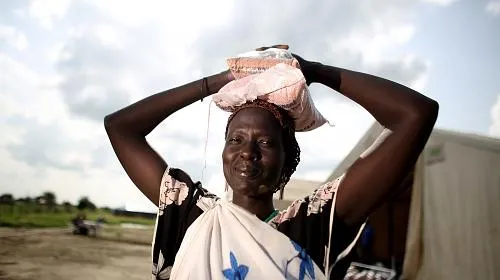Agencies fear that efforts to prevent the crisis from deteriorating will falter as rival sides regroup to resume violence once the rainy season ends this month
Juba, SOUTH SUDAN – (October 6, 2014)–CARE has joined other leading aid agencies in warning that parts of South Sudan – already the world’s worst food crisis – could fall into famine early next year if the nine-month long conflict escalates as expected.
The agencies fear that efforts this year to prevent the crisis from deteriorating will falter as rival sides are regrouping ready to resume violence once the rainy season ends this month. The number of people facing dangerous levels of hunger is expected to increase by 1 million between January and March next year.
In a report launched today, “From Crisis to Catastrophe”, the aid agencies called for neighboring governments and the wider international community to redouble diplomatic efforts to put real pressure on the parties to the conflict to end the fighting, including an arms embargo. They said so far the international community’s ‘softly-softly’ approach to the peace talks has failed to secure a meaningful cease-fire.
They also added that there needs to be an increase in both the quantity and quality of the aid effort.
Man-made crisis
Tariq Reibl head of Oxfam’s programme in South Sudan said: “If famine comes to South Sudan it will come through the barrel of a gun. This is a man-made crisis not one caused by the vagaries of the weather and though humanitarian aid is vital it cannot fix a political problem. The international community is much better at saving lives than it is at helping solve the political problems that put lives in peril. Nine months of the softly-softly approach to peace negotiations has failed. If the international community really wants to avert a famine then it has to make bold diplomatic efforts to bring both sides to end the fighting.”
The aid agencies said that a mixture of significant aid, a lull in the fighting due to the wet season and the ability of the South Sudanese to cope with hardship, has managed to stave off a famine for the moment. However they warned that now that the wet season is over, an upsurge in fighting is likely, setting back any gains made in the last few months and potentially pushing areas into famine by March 2015.
Since the current round of conflict began in South Sudan in December 2013, the country has been pushed to the brink of disaster. However the international aid effort has saved thousands of lives, much of it generously funded by the US, the UK and the EU who have given 60 per cent of the total funding. The UN Mission in South Sudan has opened its compounds to around 100,000 civilians, saving them from ethnic violence, and peace negotiations led by South Sudan’s neighbors have come close to brokering a deal.
Looking back over 2014, Aimee Ansari, CARE’s Country Director in South Sudan said: “South Sudan only just missed falling into famine this year. Partly this was due to the aid effort but much of it is due to the strength, resilience and generosity of the South Sudanese people themselves.
“But they are now at the end of their tether. You can only sell all your livestock once. Eating seeds meant for planning keeps the gnawing hunger away for the moment, but it is mortgaging the future to meet the desperate needs of the present. The people of South Sudan did what they could to survive this year – but that means they will be vulnerable next year. They need to see an end to the fighting so normal life can resume.”
Many of the 1.4 million people displaced from their homes are facing an uncertain future. The fighting has disrupted markets and pushed up food prices. Fishermen have been barred from rivers, cattle herders have had their cattle stolen, or been forced to sell them off cheaply. The expected upsurge in fighting once the rains have ended in October will tip many over the edge.
More funds are needed
The aid agencies called for donor governments to fully support the UN’s appeals for humanitarian work in South Sudan and the refugee crisis in neighboring countries. They also said that the quality of aid needs to be improved. It needs to be delivered where people are rather than where it is easier to reach. And it needs to build on the way people cope with the crisis and to enable them to face any future crisis better prepared.
The aid agencies also called on all the government of South Sudan, the opposition and other armed groups to immediately stop fighting and work towards a long-term, sustainable peace deal. All their forces need to stop attacks against civilians, end the use of child soldiers and allow humanitarian workers safe access to people needing their help.
About CARE in South Sudan:
CARE has been operating in Southern Sudan since 1993, initially providing humanitarian relief to internally displaced people in Western Equatoria. The signing of the Comprehensive Peace Agreement in 2005 allowed CARE to expand into Jonglei and Upper Nile States to support returnees from the refugee camps, and the organization has since broadened its operations to include development programs.
With the outbreak of violence in December 2013, CARE is providing emergency water, sanitation, hygiene services and education, in addition to nutrition and livelihoods assistance. CARE also supports over 40 health facilities in Unity and Upper Nile States, two of the states most heavily affected by fighting.
Founded in 1945, CARE is a leading humanitarian organization fighting global poverty. CARE has more than six decades of experience helping people prepare for disasters, providing lifesaving assistance when a crisis hits, and helping communities recover after the emergency has passed. CARE places special focus on women and children, who are often disproportionately affected by disasters. To learn more, visit www.care.org
Media contact: Holly Frew +1.770.842.6188 hfrew@care.org

